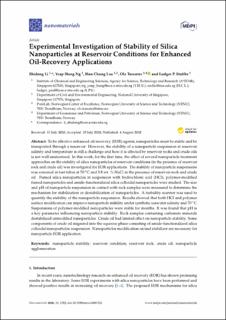| dc.contributor.author | Li, Shidong | |
| dc.contributor.author | Ng, Yeap Hung | |
| dc.contributor.author | Lau, Hon Chung | |
| dc.contributor.author | Torsæter, Ole | |
| dc.contributor.author | Stubbs, Ludger P. | |
| dc.date.accessioned | 2022-05-10T07:57:33Z | |
| dc.date.available | 2022-05-10T07:57:33Z | |
| dc.date.created | 2020-08-04T11:17:12Z | |
| dc.date.issued | 2020 | |
| dc.identifier.citation | Nanomaterials. 2020, 10 (1522), 1-15. | en_US |
| dc.identifier.issn | 2079-4991 | |
| dc.identifier.uri | https://hdl.handle.net/11250/2994948 | |
| dc.description.abstract | To be effective enhanced oil-recovery (EOR) agents, nanoparticles must be stable and be transported through a reservoir. However, the stability of a nanoparticle suspension at reservoir salinity and temperature is still a challenge and how it is affected by reservoir rocks and crude oils is not well understood. In this work, for the first time, the effect of several nanoparticle treatment approaches on the stability of silica nanoparticles at reservoir conditions (in the presence of reservoir rock and crude oil) was investigated for EOR applications. The stability of nanoparticle suspensions was screened in test tubes at 70 °C and 3.8 wt. % NaCl in the presence of reservoir rock and crude oil. Fumed silica nanoparticles in suspension with hydrochloric acid (HCl), polymer-modified fumed nanoparticles and amide-functionalized silica colloidal nanoparticles were studied. The size and pH of nanoparticle suspension in contact with rock samples were measured to determine the mechanism for stabilization or destabilization of nanoparticles. A turbidity scanner was used to quantify the stability of the nanoparticle suspension. Results showed that both HCl and polymer surface modification can improve nanoparticle stability under synthetic seawater salinity and 70 °C. Suspensions of polymer-modified nanoparticles were stable for months. It was found that pH is a key parameter influencing nanoparticle stability. Rock samples containing carbonate minerals destabilized unmodified nanoparticles. Crude oil had limited effect on nanoparticle stability. Some components of crude oil migrated into the aqueous phase consisting of amide-functionalized silica colloidal nanoparticles suspension. Nanoparticles modification or/and stabilizer are necessary for nanoparticle EOR application. | en_US |
| dc.language.iso | eng | en_US |
| dc.publisher | MDPI | en_US |
| dc.rights | Navngivelse 4.0 Internasjonal | * |
| dc.rights.uri | http://creativecommons.org/licenses/by/4.0/deed.no | * |
| dc.title | Experimental investigation of stability of silica nanoparticles at reservoir conditions for enhanced oil-recovery applications | en_US |
| dc.title.alternative | Experimental investigation of stability of silica nanoparticles at reservoir conditions for enhanced oil-recovery applications | en_US |
| dc.type | Peer reviewed | en_US |
| dc.type | Journal article | en_US |
| dc.description.version | publishedVersion | en_US |
| dc.source.pagenumber | 1-15 | en_US |
| dc.source.volume | 10 | en_US |
| dc.source.journal | Nanomaterials | en_US |
| dc.source.issue | 1522 | en_US |
| dc.identifier.doi | 10.3390/nano10081522 | |
| dc.identifier.cristin | 1821520 | |
| dc.relation.project | Norges forskningsråd: 262644 | en_US |
| cristin.ispublished | true | |
| cristin.fulltext | original | |
| cristin.qualitycode | 1 | |

